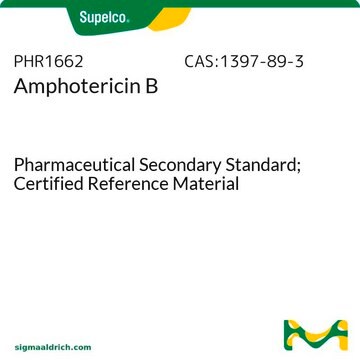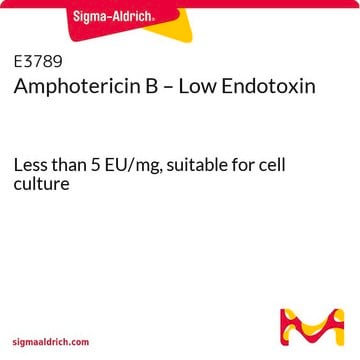A2942
Amphotericin B
solution, suitable for cell culture, BioReagent
Synonym(e):
Amphotericin, Fungizone
About This Item
Empfohlene Produkte
product name
Amphotericin B -Lösung, 250 μg/mL in deionized water, 0.1 μm filtered, BioReagent, suitable for cell culture
Qualitätsniveau
Sterilität
0.1 μm filtered
Produktlinie
BioReagent
Form
liquid
Konzentration
250 μg/mL in deionized water
Methode(n)
cell culture | mammalian: suitable
Farbe
yellow
Wirkungsspektrum von Antibiotika
fungi
yeast
Wirkungsweise
cell membrane | interferes
Versandbedingung
dry ice
Lagertemp.
−20°C
SMILES String
[H][C@]12C[C@@H](O[C@@H]3O[C@H](C)[C@@H](O)[C@H](N)[C@@H]3O)\C=C\C=C\C=C\C=C\C=C\C=C\C=C\[C@H](C)[C@@H](O)[C@@H](C)[C@H](C)OC(=O)C[C@H](O)C[C@H](O)CC[C@@H](O)[C@H](O)C[C@H](O)C[C@](O)(C[C@H](O)[C@H]1C(=O)O[Na])O2
InChI
1S/C47H73NO17/c1-27-17-15-13-11-9-7-5-6-8-10-12-14-16-18-34(64-46-44(58)41(48)43(57)30(4)63-46)24-38-40(45(59)60)37(54)26-47(61,65-38)25-33(51)22-36(53)35(52)20-19-31(49)21-32(50)23-39(55)62-29(3)28(2)42(27)56/h5-18,27-38,40-44,46,49-54,56-58,61H,19-26,48H2,1-4H3,(H,59,60)/b6-5+,9-7+,10-8+,13-11+,14-12+,17-15+,18-16+/t27-,28-,29-,30+,31+,32+,33-,34-,35+,36+,37-,38-,40+,41-,42+,43+,44-,46-,47+/m0/s1
InChIKey
APKFDSVGJQXUKY-INPOYWNPSA-N
Suchen Sie nach ähnlichen Produkten? Aufrufen Leitfaden zum Produktvergleich
Allgemeine Beschreibung
Anwendung
- als intraperitoneale Injektion zur Behandlung einer Infektion mit Aspergillus fumigatus in Mäusen
- als Bestandteil eines Ansaugmediums für die Kultur chinesischer Merinoschaf-Ovarien
- als Bestandteil eines Transportmediums bei der Sammlung von equinen Gelbkörpern
- als Zusatz in einem RPMI-Medium für die Kultur der Maus-Maus-B-Zell-Hybridom-55-6-Zelllinie
Biochem./physiol. Wirkung
Verpackung
Komponenten
Vorsicht
Angaben zur Herstellung
Sonstige Hinweise
auch häufig zusammen mit diesem Produkt gekauft
Lagerklassenschlüssel
12 - Non Combustible Liquids
WGK
WGK 1
Flammpunkt (°F)
Not applicable
Flammpunkt (°C)
Not applicable
Persönliche Schutzausrüstung
Eyeshields, Gloves, multi-purpose combination respirator cartridge (US)
Analysenzertifikate (COA)
Suchen Sie nach Analysenzertifikate (COA), indem Sie die Lot-/Chargennummer des Produkts eingeben. Lot- und Chargennummern sind auf dem Produktetikett hinter den Wörtern ‘Lot’ oder ‘Batch’ (Lot oder Charge) zu finden.
Besitzen Sie dieses Produkt bereits?
In der Dokumentenbibliothek finden Sie die Dokumentation zu den Produkten, die Sie kürzlich erworben haben.
Kunden haben sich ebenfalls angesehen
Artikel
Prevent fungal, yeast, and mold contamination in cell cultures. Discover the best antifungal agent for your cultures with the extensive Sigma® antifungal collection.
Human renal proximal tubule epithelial cells (RPTECs) are commonly used to predict human renal drug permeability and to investigate drug efflux. We have generated transporter knockout (KO) cell lines using CompoZr® Zinc Finger Nuclease (ZFN) technology in a proprietary renal proximal tubule epithelial cell line.
Antibiotic kill curve is a dose response experiment in which mammalian cells are subjected to increasing amounts of selection antibiotic
Die Abtötungskurve von Antibiotika ist ein Dosis-Wirkungs-Versuch, in dem Säugerzellen zunehmenden Mengen eines selektiven Antibiotikums ausgesetzt werden
Verwandter Inhalt
Learn how to use our cell culture tested, ready-to-use MilliShot™ single dose antibiotic solutions, conveniently packaged in one-time use vials.
Unser Team von Wissenschaftlern verfügt über Erfahrung in allen Forschungsbereichen einschließlich Life Science, Materialwissenschaften, chemischer Synthese, Chromatographie, Analytik und vielen mehr..
Setzen Sie sich mit dem technischen Dienst in Verbindung.








